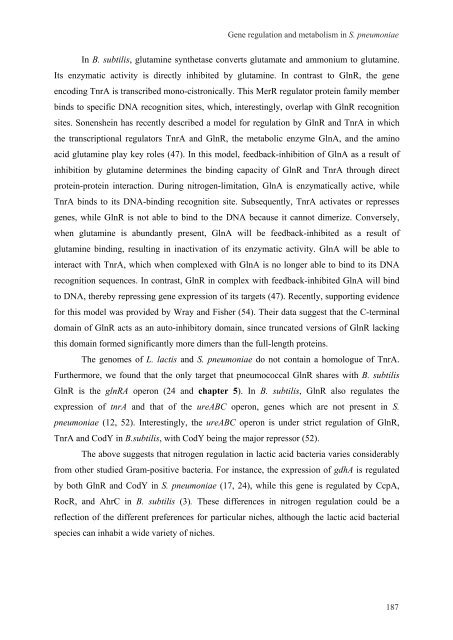Gene regulation in Streptococcus pneumoniae - RePub - Erasmus ...
Gene regulation in Streptococcus pneumoniae - RePub - Erasmus ...
Gene regulation in Streptococcus pneumoniae - RePub - Erasmus ...
You also want an ePaper? Increase the reach of your titles
YUMPU automatically turns print PDFs into web optimized ePapers that Google loves.
<strong>Gene</strong> <strong>regulation</strong> and metabolism <strong>in</strong> S. <strong>pneumoniae</strong><br />
In B. subtilis, glutam<strong>in</strong>e synthetase converts glutamate and ammonium to glutam<strong>in</strong>e.<br />
Its enzymatic activity is directly <strong>in</strong>hibited by glutam<strong>in</strong>e. In contrast to GlnR, the gene<br />
encod<strong>in</strong>g TnrA is transcribed mono-cistronically. This MerR regulator prote<strong>in</strong> family member<br />
b<strong>in</strong>ds to specific DNA recognition sites, which, <strong>in</strong>terest<strong>in</strong>gly, overlap with GlnR recognition<br />
sites. Sonenshe<strong>in</strong> has recently described a model for <strong>regulation</strong> by GlnR and TnrA <strong>in</strong> which<br />
the transcriptional regulators TnrA and GlnR, the metabolic enzyme GlnA, and the am<strong>in</strong>o<br />
acid glutam<strong>in</strong>e play key roles (47). In this model, feedback-<strong>in</strong>hibition of GlnA as a result of<br />
<strong>in</strong>hibition by glutam<strong>in</strong>e determ<strong>in</strong>es the b<strong>in</strong>d<strong>in</strong>g capacity of GlnR and TnrA through direct<br />
prote<strong>in</strong>-prote<strong>in</strong> <strong>in</strong>teraction. Dur<strong>in</strong>g nitrogen-limitation, GlnA is enzymatically active, while<br />
TnrA b<strong>in</strong>ds to its DNA-b<strong>in</strong>d<strong>in</strong>g recognition site. Subsequently, TnrA activates or represses<br />
genes, while GlnR is not able to b<strong>in</strong>d to the DNA because it cannot dimerize. Conversely,<br />
when glutam<strong>in</strong>e is abundantly present, GlnA will be feedback-<strong>in</strong>hibited as a result of<br />
glutam<strong>in</strong>e b<strong>in</strong>d<strong>in</strong>g, result<strong>in</strong>g <strong>in</strong> <strong>in</strong>activation of its enzymatic activity. GlnA will be able to<br />
<strong>in</strong>teract with TnrA, which when complexed with GlnA is no longer able to b<strong>in</strong>d to its DNA<br />
recognition sequences. In contrast, GlnR <strong>in</strong> complex with feedback-<strong>in</strong>hibited GlnA will b<strong>in</strong>d<br />
to DNA, thereby repress<strong>in</strong>g gene expression of its targets (47). Recently, support<strong>in</strong>g evidence<br />
for this model was provided by Wray and Fisher (54). Their data suggest that the C-term<strong>in</strong>al<br />
doma<strong>in</strong> of GlnR acts as an auto-<strong>in</strong>hibitory doma<strong>in</strong>, s<strong>in</strong>ce truncated versions of GlnR lack<strong>in</strong>g<br />
this doma<strong>in</strong> formed significantly more dimers than the full-length prote<strong>in</strong>s.<br />
The genomes of L. lactis and S. <strong>pneumoniae</strong> do not conta<strong>in</strong> a homologue of TnrA.<br />
Furthermore, we found that the only target that pneumococcal GlnR shares with B. subtilis<br />
GlnR is the glnRA operon (24 and chapter 5). In B. subtilis, GlnR also regulates the<br />
expression of tnrA and that of the ureABC operon, genes which are not present <strong>in</strong> S.<br />
<strong>pneumoniae</strong> (12, 52). Interest<strong>in</strong>gly, the ureABC operon is under strict <strong>regulation</strong> of GlnR,<br />
TnrA and CodY <strong>in</strong> B.subtilis, with CodY be<strong>in</strong>g the major repressor (52).<br />
The above suggests that nitrogen <strong>regulation</strong> <strong>in</strong> lactic acid bacteria varies considerably<br />
from other studied Gram-positive bacteria. For <strong>in</strong>stance, the expression of gdhA is regulated<br />
by both GlnR and CodY <strong>in</strong> S. <strong>pneumoniae</strong> (17, 24), while this gene is regulated by CcpA,<br />
RocR, and AhrC <strong>in</strong> B. subtilis (3). These differences <strong>in</strong> nitrogen <strong>regulation</strong> could be a<br />
reflection of the different preferences for particular niches, although the lactic acid bacterial<br />
species can <strong>in</strong>habit a wide variety of niches.<br />
187<br />
187

















